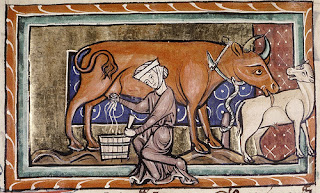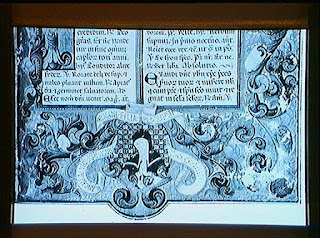During the Middle Ages, women began having few rights. Instead of being focused on women and their roles in society, medieval writers were focused on, "the opposition of Eve and Mary, seducer and saint." (Chadwick, 44) During this confusion of women's rights in the fourth or fourteenth century, women in the upper-class began to have power. These women became just as powerful as men who were upper-class, and passed the peasant women. Due to this, women had more to do outside the house just like men; women has economic and social work during the beginning of the Middle Ages. Since all these changes started to occur women encouraged to take part in property management for the family and economic life. This was a huge change for women because during this century they were just beginning to have rights, and stepping in the same shoes as men. Before all this responsibility was drizzling on women artists, they were mainly just house wives taking care of the children and the husbands. Many art emphasized how women had much labor to do.
 |
Illustration in a Bodleian Library manuscript, Ms 764, f. 41v.
(Chadwick ,42) |
|
Since there were many rules helping women rise up, this was all because of the Church's power. The Church started to enforce religion on to the people, giving everyone a fair chance just like the Bible stated. They wanted to "Stress obedience and chastity by the demands of maternal and domestic responsibility." (Chadwick, 44) Even though the Church wanted everyone to have a voice, women still did not have the same opportunities as men. Women were looked up to in Monasteries more than outside on the streets. This all turned around during the Renaissance Period when Florence found the first well-known woman artist named, Sofonisba Anguissola. The dialogue and the textures of paintings all differed, that is why Anguissola was found extraordinary. During the Middle Ages, women were just beginning to have a say in matters, and now this artist came knowing how to paint made everyone impressed. "A tradition of educated and skilled women in religious orders persisted in fourteenth-and fifteenth-century Italy." (Chadwick, 66)
After women had small hope to be educated, and work in the field of men they took advantage of that because not everything was handed easy to them. Just because they had this small opportunity to educate themselves, their society was still secularized. Women were not allowed to participate in the governmental patronage that created the public face of Renaissance Italy. This shows that women could only participate in restricted areas which was contradictory to the rights that they had from the Church. Even in such convent lives, there were few women painters who did not give up. Many, although nuns, were Maria Ormani, and Antonia. They created paintings that influenced many women artists Women not only became educated and had a taste of what it was like to be working like men, but also started to grow as painters; women began to have a voice.
 |
Breviarium cum CalendarioOrmani: Maria 15 C, Italy Manuscript 1453
(Chadwick, 69) |
Not many women during the Renaissance period became vocal and went all out to make a difference. One woman who went against the system was Barbara Bodichon. She went around her town and started to spread her insight on many topics; she hated how restricted women's voices were and wanted to make a change. She would sing,
“Oh! Isn’t it jolly,
To cast away folly,
And cut all one’s clothes a peg shorter
And rejoice in one’s legs,
Like a free-minded Albion’s daughter.” (Cherry, 13)
Barbara's bravery did not go unnoticed, because she helped women access The Divorce Act of 1857, and Women's Property Act of 1870. Not only did she help women begin to have voices but she also painted landscapes that were mostly metaphorical. Her landscapes expressed women going beyond what they see, and beyond what they think they can accomplish. Her sky and landscapes express hope that soon women will achieve more than they can imagine.
 |
Ventnor, Isle of Wight, 1856
Media: Watercolour
|
The growth of women continued into the 19th Century. Not only were they still fighting for their rights, but they were also fighting for other people's rights. "Seeking to extend the refining influence of domestic life, large numbers of middle-class women in America were caught up in Christian reform movement that promoted the abolition of slavery." (Chadwick, 205) All these movements, and activists forming together has led people to say that these actions from women are their rights as "domestic feminism." (Chadwick, 205) During the mid nineteenth century, many women transitioned from amateur art and art as a profession. Women quickly began to use their work in needlework to portray how the social action that slavery should be abolished. One of the needle workers said, "May the points of our needles prick the slave owner's conscience." (Chadwick, 207) One of the quilts was about the Bible, on how we should all come in harmony. As the 19th Century continued there were many women who grew as artists. Sculpture art became popular, women began their journey as artists, and due to some of the rights from the Church, and from Bodichon, they were soaring.
Work Cited
Chadwick, Whitney. Women, art and society. Thames and Hudson, 2015. “Beyond the Frame.” Google Books, books.google.com/books?id=bfkIAFG0c74C&pg=PA13&lpg=PA13&dq=%E2%80%9COh%21%2BIsn%E2%80%99t%2Bit%2Bjolly%2C%2BTo%2Bcast%2Baway%2Bfolly%2C%2BAnd%2Bcut%2Ball%2Bone%E2%80%99s%2Bclothes%2Ba%2Bpeg%2Bshorter%2BAnd%2Brejoice%2Bin%2Bone%E2%80%99s%2Blegs%2C%2BLike%2Ba%2Bfree-minded%2BAlbion%E2%80%99s%2Bdaughter.%E2%80%9D&source=bl&ots=KEFiz5EXvY&sig=IUJ32KDlru_WokBkgFp4QxwSzgY&hl=en&sa=X&ved=0ahUKEwjYj52Ap_XWAhWHwYMKHS5DC68Q6AEIJjAA#v=onepage&q=%E2%80%9COh!%20Isn%E2%80%99t%20it%20jolly%2C%20To%20cast%20away%20folly%2C%20And%20cut%20all%20one%E2%80%99s%20clothes%20a%20peg%20shorter%20And%20rejoice%20in%20one%E2%80%99s%20legs%2C%20Like%20a%20free-minded%20Albion%E2%80%99s%20daughter.%E2%80%9D&f=false.



No comments:
Post a Comment
Note: Only a member of this blog may post a comment.